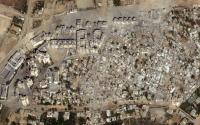20 April 2005FairfaxDigitalAndrew Darby
The largest object afloat has proved what irresistible force means. Iceberg B15A delivered on predictions, breaking the nose off a glacial ice tongue in Antarctica.
It is the latest piece of havoc caused by the 120 kilometre-long iceberg in the Ross Sea, south-east of Australia. It has already choked a shipping route, led to penguin breeding failures and reshaped the coastline and seabed.
It could have been worse. A possible "collision of the century" was predicted by the European Space Agency when it seemed that 2500 square kilometres of ice would spear straight into the Drygalski Ice Tongue.
Instead, the agency's Envisat images showed the iceberg halting just 10 kilometres short, then making a right turn.
This week, it brushed the end of the ice tongue with its shoulder, knocking off a five-kilometre-long section.
More may be broken as the iceberg's wider "stern" passes northward out of the Ross Sea.
It is the main surviving piece of the largest iceberg captured by satellite image, the 11,655-square-kilometre B15, which broke off the Ross Ice Shelf in 2000. It took with it a coastline that had been there since the heroic age of polar exploration a century earlier.
largest object afloat has proved what irresistible force means. Iceberg B15A delivered on predictions, breaking the nose off a glacial ice tongue in Antarctica.
It is the latest piece of havoc caused by the 120 kilometre-long iceberg in the Ross Sea, south-east of Australia. It has already choked a shipping route, led to penguin breeding failures and reshaped the coastline and seabed.
It could have been worse. A possible "collision of the century" was predicted by the European Space Agency when it seemed that 2500 square kilometres of ice would spear straight into the Drygalski Ice Tongue.
Instead, the agency's Envisat images showed the iceberg halting just 10 kilometres short, then making a right turn.
This week, it brushed the end of the ice tongue with its shoulder, knocking off a five-kilometre-long section.
More may be broken as the iceberg's wider "stern" passes northward out of the Ross Sea.
It is the main surviving piece of the largest iceberg captured by satellite image, the 11,655-square-kilometre B15, which broke off the Ross Ice Shelf in 2000. It took with it a coastline that had been there since the heroic age of polar exploration a century earlier.






